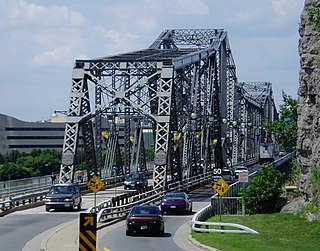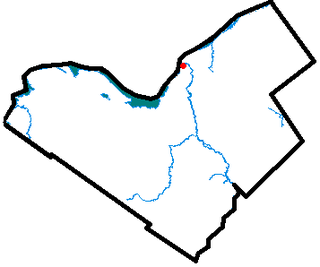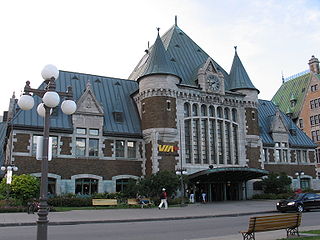
The Royal Alexandra Interprovincial Bridge, also known as the Alexandra Bridge or Interprovincial Bridge, is a steel truss cantilever bridge spanning the Ottawa River between Ottawa, Ontario and Gatineau, Quebec. In addition to carrying vehicle traffic, a shared use pathway on the bridge for pedestrians and cyclists is maintained by the National Capital Commission.

OC Transpo, officially the Ottawa-Carleton Regional Transit Commission, is the public transit agency for the city of Ottawa, Ontario, Canada. It operates an integrated hub-and-spoke system including light metro, bus rapid transit, conventional bus routes, and Para Transpo door-to-door accessible bus service that carries approximately 97.1 million annual riders.

The National Capital Region, also referred to as Canada's Capital Region and Ottawa–Gatineau, is an official federal designation for the Canadian capital of Ottawa, Ontario, the neighbouring city of Gatineau, Quebec, and surrounding urban and rural communities. The term National Capital Region is often used to describe the Ottawa–Gatineau metropolitan area, although the official boundaries of the NCR do not precisely correspond to the statistical metropolitan area.

The Senate of Canada Building is a building located at 2 Rideau Street in downtown Ottawa, Ontario, Canada that serves as the temporary seat of the Senate of Canada. The building includes the temporary Senate chamber, as well as some Senate offices and committee rooms. The building served as Ottawa's central railway station until 1966, and from 1966 to 2018 it was operated by the federal government as the Government Conference Centre.
The Bytown and Prescott Railway (B&PR) was a railway joining Ottawa with Prescott on the Saint Lawrence River. The company was incorporated in 1850, and the first train ran from Prescott into Bytown on Christmas Day, 1854. The 84 km railway, Ottawa's first to outside markets, was initially used to ship lumber collected on the Ottawa River for further shipping along the St. Lawrence to markets in the United States and Montreal.

The Hull–Chelsea–Wakefield Railway was a 33 km (20.5 mi) heritage railway in Quebec, Canada, running tourist trains through the scenic Gatineau Hills and beside the Gatineau River between Hull and the tourist town of Wakefield from May to October, using a 1907 Swedish steam locomotive, E2 class number 909, and 1940s-built Swedish passenger cars. On average, the railway attracted about 50 000 tourists and generated revenues of about $8 million for the region.

The Trillium Line, also called O-Train Line 2, is a diesel light rail transit (DLRT) service in Ottawa, Ontario, Canada, operated by OC Transpo. The line is part of the O-Train light rail system. On May 3, 2020, the Trillium Line was shut down for two years to accommodate the extension and upgrading of the line. Replacement buses will serve each station during the construction period.

Ottawa station, or Ottawa Train Station, is the main inter-city train station in Ottawa, Ontario, Canada, operated by Via Rail. It is located 4 kilometres (2.5 mi) east of downtown Ottawa and adjacent to Tremblay O-Train station in the neighbourhood of Eastway Gardens. The station serves inter-city trains connecting to Toronto, Kingston, Montreal and Quebec City on Via Rail's Corridor Route.

Lower Town (also spelled "Lowertown" is a neighbourhood in Rideau-Vanier Ward in central Ottawa, Ontario, Canada, to the east of downtown. It is the oldest part of the city. It is bounded by Rideau Street to the south, the Ottawa River to the west and north and the Rideau River to the east. It includes the commercial Byward Market area in the south-western part, and is predominantly residential in the north and east.

Gare du Palais is a train and bus station in Quebec City, Quebec, Canada. Its name comes from its proximity to the Palace of the Intendant of New France. It is served by Via Rail, Canada's national passenger railway, and by the private coach company Orléans Express.

The Chaudière Bridge crosses the Ottawa River about 1 km (0.6 mi) west of Parliament Hill, joining the communities of Gatineau, Quebec and Ottawa, Ontario, linking Rue Eddy in the Hull sector of Gatineau and Booth Street in Ottawa. The bridge is one portion of multiple spans constituting the Chaudière Crossing, which still contain portions of the first bridge linking Ottawa with Hull dating back to the time of Colonel By in the 1820s.
The Rapibus is a bus rapid transit system for the Société de Transport de l'Outaouais (STO) in the city of Gatineau, Quebec. Construction was completed in the summer of 2013 with service beginning in the fall. The Rapibus aims to speed up the service for commuters in growing sub-divisions in the northern and eastern areas of the city by alleviating the congestion on key arteries currently served by bus-designated lanes. A direct link to Ottawa is included.

The Confederation Line, also called O-Train Line 1, is a light rail line operated by OC Transpo in Ottawa, Ontario, Canada, as part of the city's O-Train light rail system. The Confederation Line opened on September 14, 2019; it is the second O-Train line opened, operating on an east to west route, including under Queen Street in the downtown core, to complement the north to south Trillium Line which operates to the west of the downtown core. Using light rail rolling stock and technology, the Confederation Line is completely grade separated.

The O-Train is a light rail transit system in Ottawa, Ontario, Canada, operated by OC Transpo. The system has two lines, the electrically-operated Confederation Line and the diesel-operated Trillium Line. Currently, Stage 2 construction has temporarily shut down the Trillium Line. When it reopens, the system will have been extended, along with the addition of two new lines, bringing the system's length to 64.5 km (40.1 mi), four lines and 41 stations. The O-Train network is fully grade separated and does not have any level crossings with roads.

The Canadian province of Quebec formed the Quebec, Montreal, Ottawa and Occidental Railway (QMO&OR) in 1874 to link those cities since private companies, without the usual subsidies from the Federal Government of Canada, could not get financing, mainly because the Grand Trunk Railway was lobbying against it.
The Gatineau LRT is a planned 26 km light rail system proposed by the Ville de Gatineau to be located in Gatineau, Quebec as well as Ottawa, Ontario. The system will be operated by Société de transport de l'Outaouais (STO), Gatineau's public transportation service. The system is planned to begin operation in 2028. Preliminary estimates put the cost of the project at $2.1 billion CAD, though this estimate does not include the Ottawa portion. The Ville de Gatineau looking to the Quebec provincial government to fund 60 percent of the project and for the Canadian federal government to fund 40 percent of the project, though neither have yet committed to funding the project.
Urban rail transit in Canada encompasses a broad range of rail mass transit systems, including commuter rail, rapid transit, light rail, and streetcar systems.















